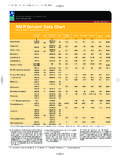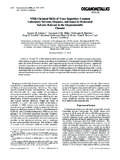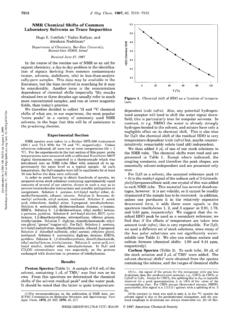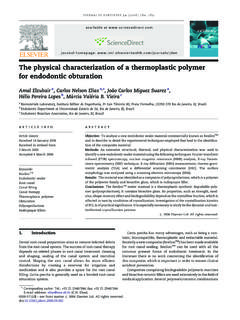Transcription of 6.1 Measuring 13C NMR Spectra - UW-Madison …
1 Copyright Hans J. Reich 20106. Carbon-13 Nuclear Magnetic Resonance Spectroscopy6-CMR-1 Measuring 13C NMR Spectra 6-CMR-2 Referencing 13C NMR Spectra6-CMR-3 Origin of Chemical Shifts6-CMR-413C Chemical Shift Effects on sp3 Carbons6-CMR-5 Alkane 13C Shifts - Calculation using Shift increments6-CMR-613C Chemical Shift Effects on sp2 and sp Carbons6-CMR-7 One-Bond Carbon-Proton Coupling (1JC-H)6-CMR-8 Two- and Three-Bond Carbon-Proton Coupling (2JC-H, 3JC-H)6-CMR-9 Long Range C-H Couplings6-CMR-10 Assignment of Carbon-13 NMR Measuring 13C NMR Spectra 13C6 I = Natural abundance: 12C6 I = 0 Natural abundance: Frequency: MHzSensitivityThe low natural abundance of 13C has three principal consequences:1. It is much harder to obtain 13C than 1H NMR Spectra .
2 Whereas an 1H spectrum on 1 mg of a typicalorganic compound can usually be obtained in 15-30 minutes of spectrometer time, it might take several hoursto obtain a much lower quality 13C spectrum on the same sample. Thus, unless your compound does nothave useful 1H signals, you will usually measure many more 1H than 13C NMR sensitivity: (1H = 100). Sens. = ((C/(H)3 Actual sensitivity: (1/5700)2. The effects of 13C nuclei on Spectra of other nuclei ( , 1H, 19F, 31P) are very minor. Each protonsignal is surrounded by 13C satellites separated by 1JC-H (typically 120-150 Hz), each with an intensity of the central peak. The central peak arises from the of 12C which is NMR transparent. The 13 Csatellites can be readily detected for sharp Coupling between carbons (JCC) is not usually observed, because two adjacent 13C nuclei occur inonly of the carbons.))
3 There are thus 13C satellites on the carbon peaks (each about of the intensityof the main peak), in the same way that there are 13C satellites on proton Spectra . The couplings can bemeasured directly with some difficulty by accumulating many scans on a very concentrated sample, but abetter way is to use one of the multi-pulse 2D experiments ( , INADEQUATE) which nulls the central peaksdue to adjacent 12C atoms. Even so, large samples and long acquisition times are (JSe-C = Hz) (JSe-C = Hz) (JSe-C = Hz) (JSe-C < 2 Hz) MHz 13C NMR Spectrum in CDCl3133132131130129128127126125ppmC4C3C 1C2 DecouplingMost 13C NMR Spectra are very complex. The methyl carbon of an ethoxy group will appear as a largequartet, with each line further split into triplets. Even in fairly simple molecules each carbon may be coupledto a number of different protons.
4 In complicated molecules, these multiplets overlap badly, and may beimpossible to = 100-250 Hz2,3 JCH . 2-10 Hz To simplify 13C Spectra , we usually use some form of broadband decoupling (noise decoupling) to removethe effect of proton couplings. This also dramatically increases signal intensity, since now all carbons appearas singlets (assuming absence of other spin 1/2 nuclei like 31P or 19F). The increase is actually greater by afactor of 2-3 than would be predicted on the basis of simply combining the 13C multiplet intensities becausethe Nuclear Overhauser Effect causes additional increases in signal intensity. More about this in Section 13C NMR spectrum of diphenyl selenide in CDCl shows the fully coupled and decoupled 13C NMR Spectra of diphenyl selenide. Althoughthe large 1JC-H splittings are easy to identify, the fine structure of the individual multiplets is not first order ( ,only the para carbon has an approximately centrosymmetric pattern, the others do not).
5 This is because weare looking at the X part of an AA'BB'CX pattern (ABC are protons, X is carbon). Since the AA' and BB parts are strongly coupled, we see the usual complex effects of "virtual coupling" on the X resonance (seeSection 5-15, 5-16). When noise {1H} decoupling is applied, the spectrum becomes much more intense, andonly 4 lines remain, one for each this compound we have a second magnetically active nucleus (77Se, natural abundance , I =1/2), so each of the 13C peaks has 77Se satellites, although coupling between C-4 and the selenium is toosmall to detect (the satellites are under the main peak).Attached Proton TestsThe disadvantage of obtaining fully decoupled Spectra is that all information about how many protonsare coupled to each carbon is lost. Since information about the number and position of C, CH, CH2 and CH3carbons is valuable in making structure and spectral assignments, several types of experiments to determine13C multiplicities have been developed (undecoupled Spectra are not usually used because of extensivesignal overlap and poor signal-to-noise).
6 Single Frequency Off-Resonance Decoupling (SFORD).This is the oldest method for determining attached protons, and has been largely replaced by moreefficient methods. In this technique powerful single frequency proton decoupling is applied 500-2000 Hzupfield or downfield of the proton chemical shifts in the sample. All C-H couplings are reduced in proportionto:1. The distance (*) from the decoupler frequency to the proton position,2. The power of the experiments would reduce the normal one-bond couplings of 125-250 Hz to perhaps 12-20 Hz,and the longer range couplings to <1 Hz. The spectrum now appears as a series of singlets, doublets, tripletsand quartet depending on whether the carbon is quaternary, or has one, two or three protons attached. Fig. 6-2 illustrates the effect of decoupler offset on the 13C NMR spectrum of Methyl carbon quartet of methanol obtained for various offsets of the decoupler frequency fromthe 1H chemical shift of methanol (from Wehrli and Wirthlin).
7 Difficulties with this technique are:1. Sensitivity is not very Multiplets are not always For complex molecules, some regions of the spectrum can become hopelessly msecdelay (1/2J) msecdelay (1/J)APTN ormalCO2 HOHO13C NMR of TriterpeneSpectral EditingThere are a number of multipulse experiments which group the signals in a 13C NMR spectrumaccording to the number of attached Spectra . This is the most primitive form of spectral editing. By placing a suitable delaytime between the pulse and the beginning of the acquisition, Spectra are obtained in which C and CH2 groupsare positive, and CH and CH3 are this experiment, after the pulse there is a short delay, during which the decoupler is turned off, andthe 13C NMR spectrum becomes modulated by the CH coupling frequency. After the delay the decoupler isturned on, and the FID is recorded.
8 If the delay is 1/J then the quaternary and CH2 carbons are positive, andthe CH and CH3 signals are negative. If the delay is 1/2J all peaks except quaternary are nulled. More on thisexperiment in Sect absenceof quaternary carbonsSmall amountof "leakage"CH onlyCH, CH3 positiveCH2 negativeDEPT (Distortionless Enhancement of Polarization Transfer): The DEPT technique has proven superiorto others in providing information on attached protons reliably, efficiently and with high selectivity. It is aproton-carbon polarization transfer method, so DEPT Spectra are actually more sensitive than normalacquisitions. A set of Spectra with pulse delays adjusted for B/2 (DEPT-90) and 3B/4 (DEPT-135) are taken. The DEPT-90 spectrum shows only CH carbons, the DEPT-135 shows positive CH3 and CH, and negativeCH2 signals.
9 It is important to understand that the appearance of positive and negative signals can bereversed by phasing, so it is necessary to have some way of determining whether the spectrum has beenphased for CH2 positive or negative. Quaternary carbons are invisible (Fig. )."Leakage" can occur in DEPT-90 Spectra because 1JC-H varies as a function of environment, and thetechnique assumes that all 1JC-H are identical. This can result in small peaks for CH2 and CH3 signals, whichshould have zero intensity. For similar reasons the C-H of terminal acetylenes (C/C-H) will show anomalousintensities in DEPT Spectra (either nulled or very small in DEPT-90, or present in DEPT-135) because the C-H coupling is much larger (around 250 Hz) than the normal value of 125 Hz for which the DEPT experiment isusually The normal 13C NMR spectrum and a typical set of DEPT Spectra of an alkyne.
10 Note theabsence of the quaternary alkyne carbons in the DEPT Spectra , and the presence of small peaks for the CH2and CH3 signals in the DEPT-90 spectrum, which, in principle, should have only CH Referencing C-13 NMR SpectraTetramethylsilane (TMS) is the primary reference for C-13 Spectra . The relatively low sensitivity of C-13 NMR requires the addition of substantial amounts of TMS, so it is common to use solvent peaks as asecondary reference. Below are listed chemical shifts of several common solvents used in NMRspectroscopy. Note that isotope shifts are quite large in C-13 NMR, so separate values are reported for thedeuterated and protonated solvents (from Levy, J. Magn. Res. 1972, 6, 143; Reich unpublished work).Compound (solvent)Protio compound (*) Per-deutero compound (*) Acid (*CO) Disulfide E90 Molecular orbital symmetryrequirement for Origin of Chemical ShiftsThere are three principal effects which control NMR chemical shifts: diamagnetic, paramagnetic andneighboring group anisotropy:Fd Diamagnetic term - electron circulation within an s orbital causes shifts to low frequency (upfield,shielding) of the local nucleus.






![Pharmacopeial Forum Vol. 35(5) [Sept.–Oct. 2009] …](/cache/preview/4/f/6/4/6/b/d/9/thumb-4f646bd9c98fa61ae166a740ef65637c.jpg)
